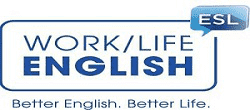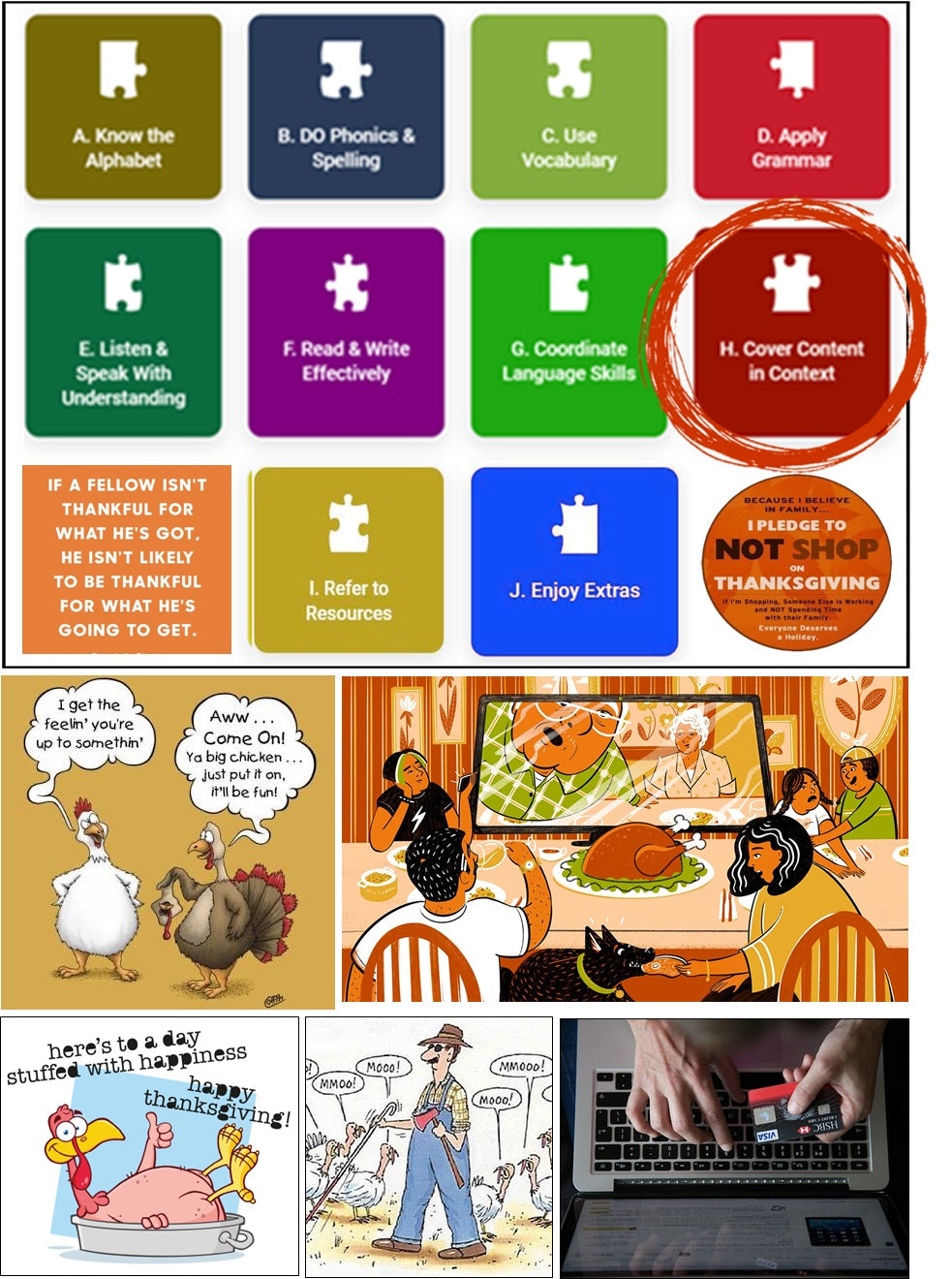Remember when we used to celebrate annual occasions in traditional ways—notably by getting together (physically) to commemorate, honor, relax, unwind, and connect? We may still associate with one another nowadays (virtually), but it seems that most of our interactions are (politically) confrontational and fraught with “differences of opinion.”
The message of it all is that no one wants to lose! Especially Educators & Learners (like you and us) want to preserve & care for what’s meaningful—to our lives, to our work, to humanity, and to our world.
So here are contributions to the “Thanksgiving Holiday” in our uncertain times—all accessible behind Puzzle Piece H: Cover Content in Context. As usual, our pedagogically linguistic focus is circled on the graphic of ten major “Puzzle Parts & Pieces A-J for Language Instruction” below. And as always, the graphic is followed by visual commentary, even a bit of levity. We’re grateful that it needs no additional explanation.
This article is the first installment of: H. Cover Content in Context in the “How to Put Together Puzzle Parts & Pieces That Make Language Work" series.
Its main aim is to help us Preserve & Enjoy the Traditions & Meanings of the Thanksgiving Holiday. It attaches to history, language skills, word usage & vocabulary, clear thinking, culture, food (for thought,) dyad & group activity, and other treasures of our thoughtfully informational “Preserve & Protect” heritage.
Why Celebrate “a Special Occasion of Gratefulness”?
Most of us are hungry to safeguard and take care of what we have that is good—and a nourishing feast of appreciation or thankfulness fits right in with that appetite. So what is it that makes us educational “preservationists” or “conservatives?” Perhaps it’s that we want to . . . "Gobbly up the 'Meat' of the Main Dish," which is the historical reality of the occassion called "Thanksgiving Day," celebrated annually in the U.S. on the 4th Thursday of November. Although it's never certain that details of the origins and developments of long-ago events are totally and objectively true, information gathered from reliable sources is likely to more fact than fiction.
Here, from a Holiday Happenings Book called Thanksgiving: Using Special-Occasion Cultural Materials in Language Skills Activities are Four Readings for Beginning Language-Learners / New Readers plus Four Selections at Intermediate Levels with two “Reading-Skills Activities”—“Getting the Point (the Main Idea)” & “The Expert Game.”

“Separate flesh from fluff & feathers,” which in instructional terms means to “distinguish fact from myth.” Many articles about the occasion have titles like “Everything You Learned About Thanksgiving is Wrong,” or “Don’t Let Fake News Ruin Your Thanksgiving.” These posts state common false beliefs about our heritage that have long since been debunked. To elucidate, one of them says:
“Not to rain on your Thanksgiving Day parade, but the story of the first Thanksgiving, as most Americans have been taught it — the Pilgrims and Native Americans gathering together, the famous feast, the turkey — is not exactly accurate. Thanksgiving facts and Thanksgiving myths have blended together for years like so much gravy and mashed potatoes, and separating them is just as complicated. Blame school textbooks with details often so abridged, softened or out of context that they are ultimately made false; children’s books that simplify the story to its most pleasant version; or animated television specials. . . [These] not only misinformed a generation, but also enforced a slew of cringeworthy stereotypes. High school textbooks are particularly bad about stating absolutes because these materials “teach history” by giving students facts to memorize even when the details may be unclear . . . That mind-set pervades everything they talk about and certainly Thanksgiving,” (Maya Salam @ The New York Times)
So part of teaching / learning proven historical facts—so very relevant in our nerve-racking, hard-to-believe-or-learn-from times, is “separating what’s valid from manipulative invention.”
Here, from the book Thanksgiving: Using Special-Occasion Cultural Materials in Language Skills Activities is a ten-page section called Thanksgiving: “Distinguishing Fact from Myth. With “Signal Phrase” vocabulary that differentiates between “Objective Fact / Truth” and “Point of View / Myth,” it presents the concept of setting unbiased facts apart from subjective opinion.
Then come four paired pages: the first of each pair has four illustrated Sentence-Strips stating Myths about the holiday; the second shows four corresponding small-print Explanations of researched Reality. The Download ends with suggestions of how to use the material in education that values “critical thinking” or “objective analysis.”

“Get the ‘Fixin’s’ in a Cornucopia of Entrées & Side Dishes."
How about equating the core of Subject Matter (its Topic—such as the traditional holiday of Thanksgiving) with the “main course” (e.g., turkey, ham, veal, mutton, venison, chuck roast, and other terms for foods high in protein) of a flavorful feast? Then the “side dishes” could be the Vocabulary that feeds our abilities to taste, savor, and digest—or in linguistic terms, to understand, express, and communicate knowledge, thoughts, and ideas.
As "appetizers," we might try “Using Parts of Speech as a Learning Tool.” Then come filling "sides" of potatoes and stuffing—”Guessing Meaning from Context” with clues such as Position, Function, Definitions, Synonyms, Opposites, Examples, Categories of Meaning, and General Impression. These can be arranged in or on “Tables.” Individual dishes of vegetables, salads, sauces, breads, & condiments can then be placed into slots of Cloze (Deletion) Tests around Centerpieces that promote the Holiday Theme. "Desserts, " of course, can be tasted in sweet Vocabulary Games.
Nine Thanksgiving Book pages 28-36 serve up Vocabulary Skills Activities: Parts of Speech & Vocabulary from Context (Charts), Selections on “the Pilgrim Ship” the Mayflower” & “the 1627 Pilgrim Village.” For the whole menu, click above—or on the excerpted visuals displayed below.
“Fill in Recipe Gaps for Cooperative Cooking.”
Just as Vocabulary can insert what’s missing into Instructional Readings with Blanks, “Information-Gap Activities” can complete our (food & learning) preparation processes. By working together to get what we need (to understand or do) and share what we have (or know), we can Fill the Voids not only in our stomachs but also in our knowledge and know-how.
Here from the same celebratory sources are “Listening / Speaking Activities” with “Information-Gap Pairwork.” If there are still shortcomings in our communication processes, recipes for “Basic Bread Stuffing” (Displayed Below.) and “Candied Yams” (Not displayed here, but included in the download.) will help us to correct them.
“Put Sequenced Steps into ‘Cooking’ Processes.”
What matters in preparation or consumption of “a moveable feast of food for thought” in language, history, culture, and other subject-matter learning? Not only is it the amounts of ingredients and actions we take; it’s also the order or sequence of steps.
Here in Sequenced Action Series: Teaching / Learning “How to Make & Carve a Thanksgiving Turkey” are simulations that require the same kinds of communicative competence and cooperation as many dyad or group language and content lessons. As usual in topic-based, contextualized instruction, these theme-based instructions are both practical and fun to follow—and they may even yield delicious results (more mental nourishment to chew on).
Compare & Contrast What We See, Read, Hear, Buy, or Otherwise Consume & Digest on Special Occasions.
Whether we’re cooking or eating, washing up or watching, worrying or doing, accepting or activating, and/or teaching or learning, a lot of what we end up with under any educational, work, or everyday (media) circumstances involves juxtaposing, analogizing, correlating, and finding differences.
Here from the Thanksgiving Book is a section called Comparing & Contrasting: Visuals & Reading Selections. Its pages display historical painting and drawings; myth statements vs. idealized depictions or stereotypical cartoons; presidential “proclamations;" photos of food (with people about to devour it); articles about and recipes for traditional vs. modern dishes; and readings about giving thanks in other places or times (Canada, Alaska, Hawaii). It’s all useful practice in making decisions about what we believe (in), think, learn, teach others, say, write, and so on—and what or how we choose to celebrate.
Serve Up a Generous Portion of Gratefulness Seasoned with Peppery Desserts of Fun & Games
We’re thankful that we have the time, energy, experience, know-how, and impetus to collect, present, and share our information, thoughts, concepts, and hopes—with everyone that values knowledge of history & heritage, rational thought about human relations & progress in the world, and whatever else is (objectively or subjectively) important.
So in sections called Writing Skills Activities (Expressing Thanks in Letters of Gratefulness) & Miscellaneous Skills Activities (Holiday Humor), here are three Letters of Thanksgiving that are vintage memos of gratefulness. You’re welcome to use them as models for your own reactions and feelings—and/or to craft your own unique contributions.
For holiday laughter and fun, there are “17th Century Pilgrim Children’s Riddles,” “Brain Teasers,” Cartoons, Jokes, a Poem, a “Roll a Turkey” Dice Game; a possible “Bingo Board,” and three Word Puzzles—all on the holiday theme that has become very much part of our repertoire by now.
So . . . heartfelt and hearty thanks to you and yours for helping to find a way out of the chaos into rationality, reconciliation, and optimism. Here’s to preserving & caring for what’s meaningful—to our lives, to our work, to humanity, and to our world.
Want more Special-Occasion Cultural Materials for Language-Skills Activities? Here are (other) products classified as “Holiday Happenings”—as well as U.S. Citizenship & Americana texts and games:
For monthly email newsletters with free tips, tools, and resources for English language teachers and learners, sign up here!












